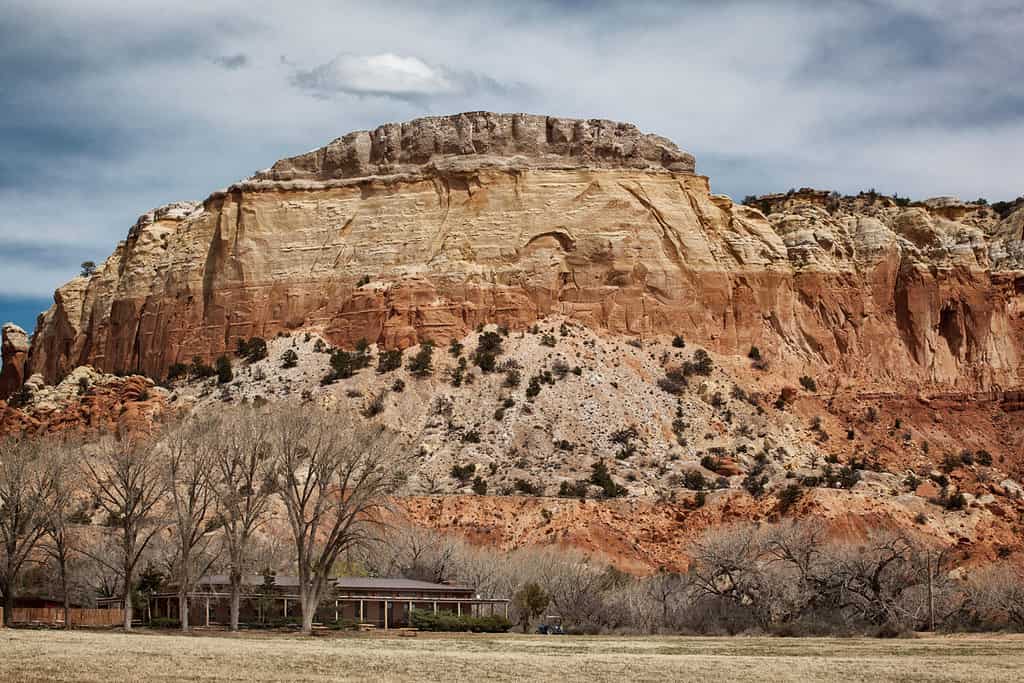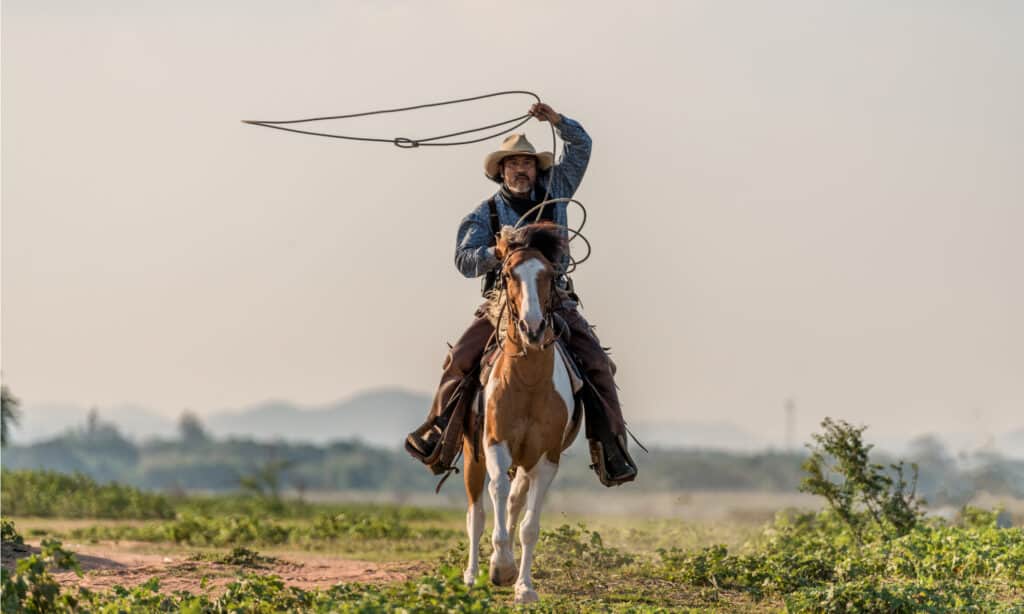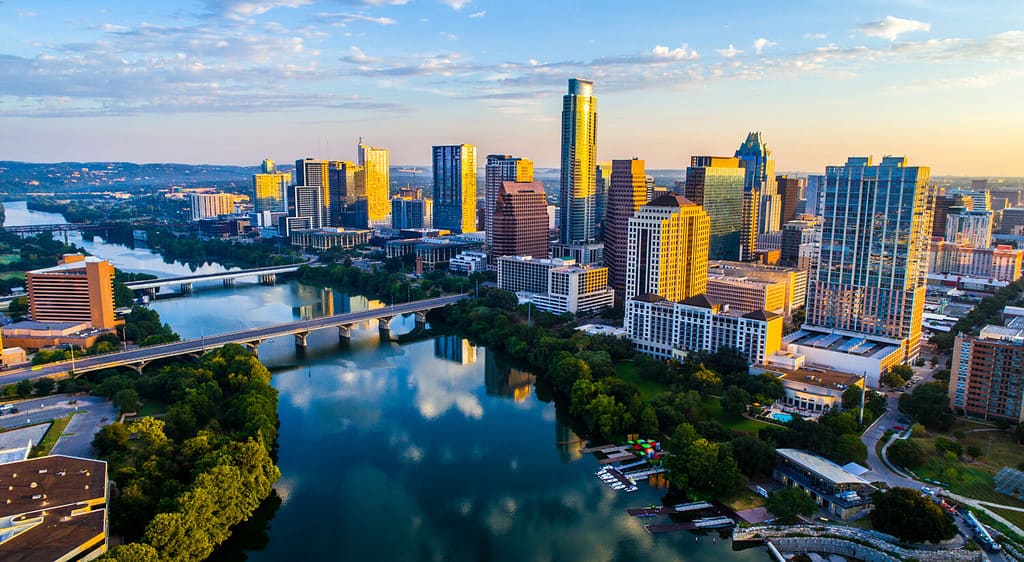Texas, the Lone Star State, is not only renowned for its rich history, vibrant culture, and sprawling landscapes but also for its vast tracts of land that stretch as far as the eye can see. Texas encapsulates the essence of wide-open spaces, from the undulating hills around Austin to the remote towns adorned with tumbleweeds out west. Surprisingly, nearly 95% of Texas land is privately owned, solidifying its status as one of the states with the Country’s highest percentage of private land ownership. Nevada, a neighboring state, follows a different pattern. Approximately 80% of Nevada’s land is owned by the government, highlighting these two states’ distinct land ownership dynamics.

Nearly 95% of Texas land is privately owned.
©James Orndorf/Shutterstock.com
Texas is a big state, and its home to some of the largest landowners in the Country. Below is a list of the top ten landowners in Texas.
1. The King Ranch
825,000 acres
The King Ranch is one of the largest ranches in the world and covers over 825,000 acres of land. The King Ranch in South Texas is among the most legendary and iconic ranches. Established in 1853 by Captain Richard King and Gideon K. Lewis, this sprawling ranch has become synonymous with Texas ranching heritage and has left an indelible mark on the state’s history.
Encompassing a staggering 825,000 acres, the King Ranch is larger than Rhode Island. Its vast expanse stretches across multiple counties, including Kleberg, Kenedy, Brooks, and Willacy. The ranch’s size alone is a testament to its significance in the ranching world.
Additionally, the iconic King Ranch has influenced the agricultural and ranching sectors and impacted popular culture. Its distinctive “Running W” brand, signifying the ranch’s legacy, is instantly recognizable. The ranch has been featured in numerous books, films, and television shows, cementing its status as an emblem of Texas ranching tradition.
Throughout its long history, the King Ranch has remained family-owned and has been passed down through several generations. The descendants of Captain Richard King have continued to uphold his legacy, ensuring the preservation and prosperity of this iconic Texan landmark.
2. The Briscoe Family
640,000 acres
BasicallyThe Briscoe family is another prominent landowner in Texas, with over 640,000 acres of land. The family’s holdings include ranches, oil and gas operations, and real estate developments.
The Briscoe Family Ranch, located in southern Texas, is a prominent and storied landholding that has played a significant role in the state’s ranching legacy. Owned by the Briscoe family, the ranch spans vast acreage and encompasses diverse landscapes, showcasing Texas’s natural beauty and rugged charm.
The Briscoe Family Ranch is in Uvalde County, known for its scenic vistas and rich history. However, the exact size of the ranch may vary, as land ownership can fluctuate, but it is estimated to be several thousand acres, making it a substantial and expansive property.
Significantly, ranching has been a way of life for the Briscoe family for generations. Led by former Texas Governor Dolph Briscoe Jr., the family has upheld a strong commitment to land stewardship and preserving the ranch’s natural resources. This dedication has earned the Briscoe Family Ranch a reputation for sustainable and responsible land management practices.
Cattle ranching is a central focus of the Briscoe Family Ranch’s operations. Similarly, the ranch has a history of raising high-quality beef cattle, often incorporating innovative techniques and advancements to ensure optimal herd health and productivity. The Briscoe family’s expertise and passion for ranching have contributed to the success of their cattle operations.
In addition to ranching, the Briscoe Family Ranch engages in various other agricultural activities. This includes cultivating crops such as hay, corn, and wheat, which provide essential feed for the cattle. The ranch’s diverse agricultural operations contribute to its sustainability and economic viability.

The Briscoe family’s expertise and passion for ranching have contributed to the success of their cattle operations.
©Bob Pool/Shutterstock.com
3. The O’Connor Family
587,000 acres
The O’Connor family is one of the Texa’s oldest and most prominent landowners, with approximately 587,000 acres of land. The family’s holdings include ranches, oil and gas operations, and a resort. The O’Connor Family Ranch, located in Goliad County, Texas, holds historical significance as a cherished property passed down through several generations. With a focus on cattle ranching and a commitment to land stewardship, the O’Connor Family Ranch has earned a reputation for producing high-quality livestock. At the same time, primarily a private property, scenic landscapes, and rich heritage have occasionally made it a sought-after location for special events. The O’Connor Family Ranch is a testament to Texas ranching traditions and the enduring spirit of land preservation.
4. The Wilks Brothers
350,000 acres
The Wilks brothers are entrepreneurs who made their fortune in the fracking industry.
The Wilks Brothers, well-known for their success in the energy industry, also own a substantial ranch in Texas. While details about the ranch’s operations are limited, the Wilks Brothers’ land likely serves multiple purposes, including potential involvement in agricultural activities. As private individuals, public access to the Wilks Brothers’ ranch may be restricted, but their ownership reflects their significant presence and influence in the Texan landscape. They own over 350,000 acres of land in Texas and are known for their conservative political views.
5. The Reynolds Family
250,000 acres
The Reynolds family owns over 250,000 acres of land in Texas, which they use for ranching and wildlife conservation. They are also involved in the oil and gas industry.
6. The Faskan Family
227,000 acres
The Fasken family, a prominent name in Texas, boasts an extensive landholding that exceeds 227,000 acres. This substantial property serves multiple purposes, including ranching and engaging in oil and gas operations. Their diversified land usage reflects their agricultural and energy sectors’ involvement. In addition to ranching, the Fasken family is actively involved in oil and gas operations. The vast landholdings allow them to explore and extract valuable energy resources.

The Fasken family, a prominent name in Texas, boasts an extensive landholding that exceeds 225,000 acres.
©chaowat kawera/Shutterstock.com
7. The Hughes Family
175,000 acres
Ranking at number 7 on the list of largest landowners in Texas, the Hughes family commands an impressive land portfolio, boasting ownership of over 175,000 acres. Their extensive holdings encompass various assets, including ranches, oil and gas operations, and real estate developments.
8. The Graham Family
171,000 acres
The Graham family, a notable presence in Texas, holds a substantial land portfolio exceeding 171,000 acres. Their land usage encompasses ranching and oil and gas operations, reflecting their involvement in critical industries.
9. The Shelton Family
130,000 acres
The Shelton family commands a substantial land portfolio, owning more than 130,000 acres in Texas. Additionally, their diverse land holdings are primarily utilized for ranching and engaging in oil and gas operations.
10. The Bentsen Family
130,000 acres
With an impressive landholding exceeding 130,000 acres, the Bentsen family has established a significant presence in Texas. Their diverse land portfolio is a platform for ranching and oil and gas operations.
Other Large Land Owners in the United States
Bill Gates, the co-founder of Microsoft, has an estimated land ownership of around 270,000 acres; Gates has secured the position of the largest individual landowner in the Country. Other notable families hold the records for vast landholding in the United States.
1. Emmerson Family
2,33,000 acres
The Emmerson family, based in California, is recognized as the largest private landowner in the United States. Subsequently, they own extensive timberlands and forested areas, with an estimated total land ownership of 2,330,000 acres.
2. Ted Turner
2,000,000 acres
People know Media mogul Ted Turner, founder of CNN, his substantial land ownership. He ranks as one of the largest individual landowners in North America, with approximately two million acres of private and ranch land spread across eight U.S. states and Argentina.
3. The Irving Family
1,200,000 acres
Based in Canada but with significant land holdings in the United States, the Irving family owns extensive timberland in Maine and various properties in other states. Their land ownership is estimated to be over 1.2 million acres.
4. The Reed Family
1,370,000 acres
The Reed family, with origins in Nevada, holds substantial land in the state, including the expansive Paradise Valley Ranch. People estimate their land ownership to be around 1,370,000 acres.
5. The Pingree Family
1,000,000 acres
The Pingree family, descendants of a 19th-century timber baron, owns significant timberlands in Maine and Michigan. People estimate their land ownership to be over 1 million acres.
Texas Fun Facts

People know Austin, the capital city of Texas, for its vibrant music scene.
©Roschetzky Photography/Shutterstock.com
- Texas is the second-largest state in the United States, both in terms of land area and population. It covers approximately 268,596 square miles (695,662 square kilometers) and is home to over 29 million people.
- The state motto of Texas is “Friendship,” reflecting its residents’ welcoming and hospitable nature.
- People often call Texas the “Lone Star State” due to its former status as an independent republic and its prominent lone star symbol on the state flag.
- People know Austin, the capital city of Texas, for its vibrant music scene. People hailed it as the “Live Music Capital of the World,” and the city hosts the annual South by Southwest (SXSW) festival, attracting musicians and artists from around the globe.
- Texas is rich in natural resources, including oil and gas. It has been a leading oil producer in the United States, and the discovery of the Spindletop oil field in 1901 played a significant role in the state’s economic development.
More Fun Facts
- People know Texas for its love of sports, particularly American football. Citizens follow high school football with intense rivalries and passionate fans. The Dallas Cowboys, based in Arlington, are one of the most popular and successful professional football teams in the Country.
- People know Texas for several world-class cultural institutions and landmarks, such as the Alamo in San Antonio, which played a crucial role in the Texas Revolution. The NASA Johnson Space Center in Houston is a significant hub for space exploration and houses the Mission Control Center for the U.S. human spaceflight program.
- People know Texas for its diverse cuisine, influenced by Mexican, Southern, and cowboy traditions. Tex-Mex dishes, barbecue, and chili are the state’s culinary specialties.
- The state animal of Texas is the armadillo, known for its unique armored shell. People find various regions of Texas as a cultural symbol of the state.
- Texas has a rich cowboy and ranching heritage, with iconic cattle ranches and rodeos that showcase traditional cowboy skills and traditions. The Fort Worth Stockyards is a popular tourist destination, offering visitors a glimpse into Texas’ cowboy culture.
Famous Texas Celebrities
Texas has been home to numerous renowned celebrities who have made significant contributions to the entertainment industry. Here are some famous Texas celebrities:
Beyoncé
Born and raised in Houston, Beyoncé became a global superstar known for her powerhouse vocals, captivating performances, and empowering lyrics. She won numerous Grammy Awards and is considered one of her generation’s most influential and successful musicians.
Matthew McConaughey
This Academy Award-winning actor hails from Uvalde, Texas. Known for his roles in films like “Dallas Buyers Club,” “Interstellar,” and “Dazed and Confused,” McConaughey has established himself as a versatile and charismatic performer.
Selena Gomez
Born in Grand Prairie, Texas, Selena Gomez gained fame as an actress in the television series “Wizards of Waverly Place.” Consequently, she has since transitioned into a successful music career, with hit songs like “Come & Get It” and “Bad Liar.”
Jamie Foxx
Born in Terrell, Texas, Jamie Foxx is an artist who is an actor, comedian, and singing skills. He has won an Academy Award for portraying Ray Charles in the film “Ray” and has achieved success in both music and comedy.
Sandra Bullock
This Oscar-winning actress was born in Arlington, Texas. Known for her roles in films such as “Speed,” “The Blind Side,” and “Gravity,” and because of this, Sandra Bullock has become one of Hollywood’s most beloved and respected actresses.
Ranching in Texas

Texas’s vast grasslands and favorable climate created optimal conditions for flourishing ranching operations.
©iStock.com/jeannehatch
Ranching has a deep-rooted history in Texas, dating back to the Spanish colonial era. Significantly, raising livestock, particularly cattle, played a vital role in the region’s early settlement and economic development.
The arrival of Spanish explorers and settlers in the 16th century brought the tradition of livestock herding. People introduced cattle, horses, and sheep to the vast open spaces of Texas. The rugged and expansive landscapes provided ideal conditions for grazing, allowing herds to thrive.
Over time, ranching became an integral part of the Texan way of life. Likewise, cattle were raised primarily for meat and hides, while horses were used for transportation and working the land. The vast grasslands and favorable climate created optimal conditions for flourishing ranching operations.
In the mid-19th century, the era of the great cattle drives emerged. As demand for beef increased in the eastern markets, People herded cattle over long distances to railheads, such as Abilene and Dodge City, for shipment to the meatpacking centers. Correspondingly, cowboys, known as “cowhands” or “vaqueros,” were pivotal in driving and managing the herds during these epic journeys.
Continued Ranching in Texas
The invention of barbed wire in the late 19th century revolutionized the ranching industry. The widespread use of fencing allowed for the enclosure and control of livestock, leading to larger and more efficient ranches. Because of this, ranchers began to focus on selective breeding, improving the quality of cattle breeds, and implementing modern practices for better management.
Consequently, the introduction of railroads further propelled the growth of the ranching industry. In fact, with the expansion of rail networks, cattle could be transported more efficiently and over longer distances, opening up new markets for Texas ranchers. This era marked the transition from open-range ranching to more intensive and commercialized operations.
Because of this, ranching remains integral to Texas’ cultural and economic landscape. The state continues to be one of the leading beef producers in the United States, with countless ranches dotting its vast expanses. From small family-owned operations to massive corporate farms, Texas proudly upholds its legacy as the heartland of American ranching.
The photo featured at the top of this post is © JMY Photography/Shutterstock.com
Thank you for reading! Have some feedback for us? Contact the AZ Animals editorial team.






